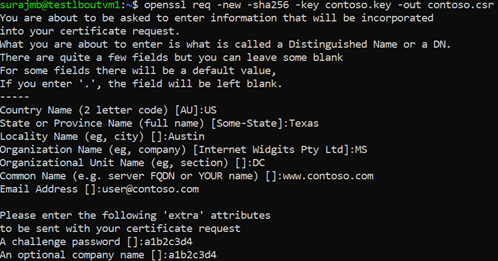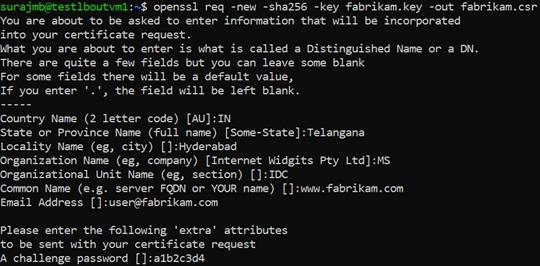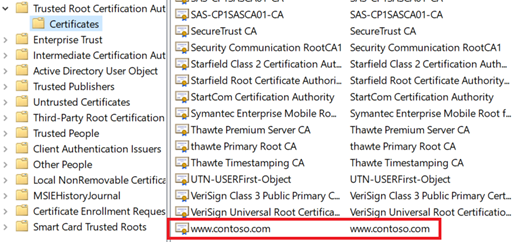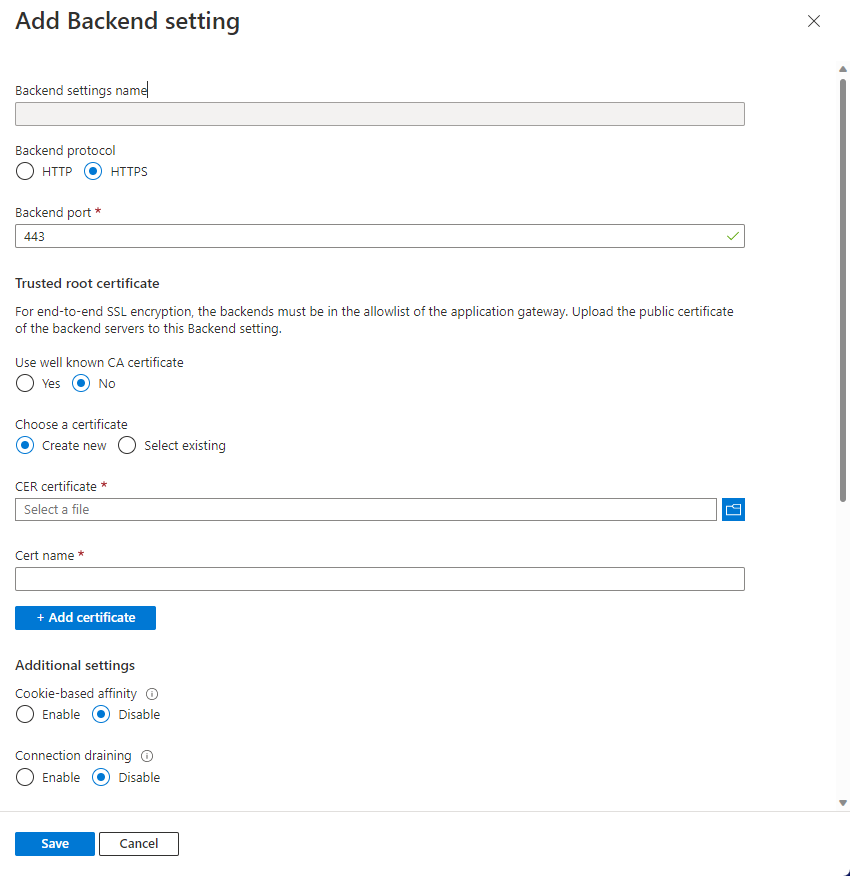Generate an Azure Application Gateway self-signed certificate with a custom root CA
The Application Gateway v2 SKU introduces the use of Trusted Root Certificates to allow TLS connections with the backend servers. This provision removes the use of authentication certificates (individual Leaf certificates) that were required in the v1 SKU. The root certificate is a Base-64 encoded X.509(.CER) format root certificate from the backend certificate server. It identifies the root certificate authority (CA) that issued the server certificate and the server certificate is then used for the TLS/SSL communication.
Application Gateway trusts your website's certificate by default if it's signed by a well-known CA (for example, GoDaddy or DigiCert). You don't need to explicitly upload the root certificate in that case. For more information, see Overview of TLS termination and end to end TLS with Application Gateway. However, if you have a dev/test environment and don't want to purchase a verified CA signed certificate, you can create your own custom Root CA and a leaf certificate signed by that Root CA.
Note
Self-generated certificates are not trusted by default, and can be difficult to maintain. Also, they may use outdated hash and cipher suites that may not be strong. For better security, purchase a certificate signed by a well-known certificate authority.
You can use the following options to generate your private certificate for backend TLS connections.
Use the one-click private certificate generator tool. Using the domain name (Common Name) that you provide, this tool performs the same steps as documented in this article to generate Root and Server certificates. With the generated certificate files, you can immediately upload the Root certificate (.CER) file to the Backend Setting of your gateway and the corresponding certificate chain (.PFX) to the backend server. The password for the PFX file is also supplied in the downloaded ZIP file.
Use OpenSSL commands to customize and generate certificates as per your needs. Continue to follow the instructions in this article if you wish to do this entirely on your own.
In this article, you will learn how to:
- Create your own custom Certificate Authority
- Create a self-signed certificate signed by your custom CA
- Upload a self-signed root certificate to an Application Gateway to authenticate the backend server
Prerequisites
OpenSSL on a computer running Windows or Linux
While there could be other tools available for certificate management, this tutorial uses OpenSSL. You can find OpenSSL bundled with many Linux distributions, such as Ubuntu.
A web server
For example, Apache, IIS, or NGINX to test the certificates.
An Application Gateway v2 SKU
If you don't have an existing application gateway, see Quickstart: Direct web traffic with Azure Application Gateway - Azure portal.
Create a root CA certificate
Create your root CA certificate using OpenSSL.
Create the root key
Sign in to your computer where OpenSSL is installed and run the following command. This creates an encrypted key.
openssl ecparam -out contoso.key -name prime256v1 -genkey
Create a Root Certificate and self-sign it
Use the following command to generate the Certificate Signing Request (CSR).
openssl req -new -sha256 -key contoso.key -out contoso.csrWhen prompted, type the password for the root key, and the organizational information for the custom CA such as Country/Region, State, Org, OU, and the fully qualified domain name (this is the domain of the issuer).

Use the following command to generate the Root Certificate.
openssl x509 -req -sha256 -days 365 -in contoso.csr -signkey contoso.key -out contoso.crtThe previous commands create the root certificate. You'll use this to sign your server certificate.
Create a server certificate
Next, you'll create a server certificate using OpenSSL.
Create the certificate's key
Use the following command to generate the key for the server certificate.
openssl ecparam -out fabrikam.key -name prime256v1 -genkey
Create the CSR (Certificate Signing Request)
The CSR is a public key that is given to a CA when requesting a certificate. The CA issues the certificate for this specific request.
Note
The CN (Common Name) for the server certificate must be different from the issuer's domain. For example, in this case, the CN for the issuer is www.contoso.com and the server certificate's CN is www.fabrikam.com.
Use the following command to generate the CSR:
openssl req -new -sha256 -key fabrikam.key -out fabrikam.csrWhen prompted, type the password for the root key, and the organizational information for the custom CA: Country/Region, State, Org, OU, and the fully qualified domain name. This is the domain of the website and it should be different from the issuer.

Generate the certificate with the CSR and the key and sign it with the CA's root key
Use the following command to create the certificate:
openssl x509 -req -in fabrikam.csr -CA contoso.crt -CAkey contoso.key -CAcreateserial -out fabrikam.crt -days 365 -sha256
Verify the newly created certificate
Use the following command to print the output of the CRT file and verify its content:
openssl x509 -in fabrikam.crt -text -noout
Verify the files in your directory, and ensure you have the following files:
- contoso.crt
- contoso.key
- fabrikam.crt
- fabrikam.key
Configure the certificate in your web server's TLS settings
In your web server, configure TLS using the fabrikam.crt and fabrikam.key files. If your web server can't take two files, you can combine them to a single .pem or .pfx file using OpenSSL commands.
IIS
For instructions on how to import certificate and upload them as server certificate on IIS, see HOW TO: Install Imported Certificates on a Web Server in Windows Server 2003.
For TLS binding instructions, see How to Set Up SSL on IIS 7.
Apache
The following configuration is an example virtual host configured for SSL in Apache:
<VirtualHost www.fabrikam:443>
DocumentRoot /var/www/fabrikam
ServerName www.fabrikam.com
SSLEngine on
SSLCertificateFile /home/user/fabrikam.crt
SSLCertificateKeyFile /home/user/fabrikam.key
</VirtualHost>
NGINX
The following configuration is an example NGINX server block with TLS configuration:

Access the server to verify the configuration
Add the root certificate to your machine's trusted root store. When you access the website, ensure the entire certificate chain is seen in the browser.

Note
It's assumed that DNS has been configured to point the web server name (in this example,
www.fabrikam.com) to your web server's IP address. If not, you can edit the hosts file to resolve the name.Browse to your website, and click the lock icon on your browser's address box to verify the site and certificate information.
Verify the configuration with OpenSSL
Or, you can use OpenSSL to verify the certificate.
openssl s_client -connect localhost:443 -servername www.fabrikam.com -showcerts

Upload the root certificate to Application Gateway's HTTP Settings
To upload the certificate in Application Gateway, you must export the .crt certificate into a .cer format Base-64 encoded. Since .crt already contains the public key in the base-64 encoded format, just rename the file extension from .crt to .cer.
Azure portal
To upload the trusted root certificate from the portal, select the Backend Settings and select HTTPS in the Backend protocol.

Azure PowerShell
Or, you can use Azure CLI or Azure PowerShell to upload the root certificate. The following code is an Azure PowerShell sample.
Note
The following sample adds a trusted root certificate to the application gateway, creates a new HTTP setting and adds a new rule, assuming the backend pool and the listener exist already.
## Add the trusted root certificate to the Application Gateway
$gw=Get-AzApplicationGateway -Name appgwv2 -ResourceGroupName rgOne
Add-AzApplicationGatewayTrustedRootCertificate `
-ApplicationGateway $gw `
-Name CustomCARoot `
-CertificateFile "C:\Users\surmb\Downloads\contoso.cer"
$trustedroot = Get-AzApplicationGatewayTrustedRootCertificate `
-Name CustomCARoot `
-ApplicationGateway $gw
## Get the listener, backend pool and probe
$listener = Get-AzApplicationGatewayHttpListener `
-Name basichttps `
-ApplicationGateway $gw
$bepool = Get-AzApplicationGatewayBackendAddressPool `
-Name testbackendpool `
-ApplicationGateway $gw
Add-AzApplicationGatewayProbeConfig `
-ApplicationGateway $gw `
-Name testprobe `
-Protocol Https `
-HostName "www.fabrikam.com" `
-Path "/" `
-Interval 15 `
-Timeout 20 `
-UnhealthyThreshold 3
$probe = Get-AzApplicationGatewayProbeConfig `
-Name testprobe `
-ApplicationGateway $gw
## Add the configuration to the HTTP Setting and don't forget to set the "hostname" field
## to the domain name of the server certificate as this will be set as the SNI header and
## will be used to verify the backend server's certificate. Note that TLS handshake will
## fail otherwise and might lead to backend servers being deemed as Unhealthy by the probes
Add-AzApplicationGatewayBackendHttpSettings `
-ApplicationGateway $gw `
-Name testbackend `
-Port 443 `
-Protocol Https `
-Probe $probe `
-TrustedRootCertificate $trustedroot `
-CookieBasedAffinity Disabled `
-RequestTimeout 20 `
-HostName www.fabrikam.com
## Get the configuration and update the Application Gateway
$backendhttp = Get-AzApplicationGatewayBackendHttpSettings `
-Name testbackend `
-ApplicationGateway $gw
Add-AzApplicationGatewayRequestRoutingRule `
-ApplicationGateway $gw `
-Name testrule `
-RuleType Basic `
-BackendHttpSettings $backendhttp `
-HttpListener $listener `
-BackendAddressPool $bepool
Set-AzApplicationGateway -ApplicationGateway $gw
Verify the application gateway backend health
- Click the Backend Health view of your application gateway to check if the probe is healthy.
- You should see that the Status is Healthy for the HTTPS probe.

Next steps
To learn more about SSL\TLS in Application Gateway, see Overview of TLS termination and end to end TLS with Application Gateway.